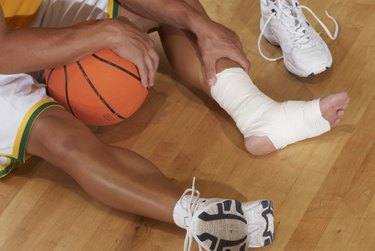
Using cold and heat therapies correctly can help speed the healing of injuries such as a strained Achilles tendon. Using them incorrectly won't cause serious damage, but doing so can increase pain and swelling, rather than reduce them. Understanding the physiological effect of hot and cold treatments will help you choose the correct treatment at the correct time.
Achilles Tendon Strain
Video of the Day
The Achilles tendon, also called the calcaneal tendon, is a tough strap of tissue that connects the gastrocnemius and soleus muscles in your calf to your heel. A strain is a minor injury, due to micro-tears in the tendon. The strain can be a result of overuse, wear and tear or trauma. The resulting inflammation causes swelling and pain, especially while moving your foot.
Video of the Day
Cold Therapy
Ice produces vasoconstriction -- the local capillaries shrink -- which makes the capillaries less permeable, resulting in less swelling. It helps relieve pain because it decreases local nerve sensation. On the other hand, ice also makes muscles stiff and decreases muscle strength. You should not use ice if you are shivering or have peripheral vascular disease, open wounds or hypersensitivity to cold.
Heat Therapy
Heat causes vasodilation -- the local blood capillaries open up -- which creates increased blood flow and brings oxygen and nutrients to the injured area. Heat relaxes muscles, decreases pain and improves range of motion. On the other hand, it also increases swelling. You should not use heat if you are bleeding, have open wounds, a burn, a local malignant tumor or peripheral vascular disease. Don't use heat if the area is already red and hot or blistered.
Indications
Ice is more effective for acute conditions. Use it for recent injuries -- in the first 24 to 48 hours after you strain your Achilles tendon. After the first 24 to 48 hours, when your strained Achilles tendon has begun to heal, use heat to increase circulation, which brings nutrients and white blood cells to the area, speeding the healing process.
Is this an emergency? If you are experiencing serious medical symptoms, please see the National Library of Medicine’s list of signs you need emergency medical attention or call 911.